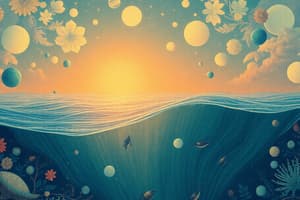Podcast
Questions and Answers
What primarily causes the formation of dead zones in water bodies?
What primarily causes the formation of dead zones in water bodies?
- Excessive nutrient runoff (correct)
- High water temperatures
- Overfishing practices
- Industrial wastewater discharge
Which of the following is a socio-economic impact of dead zones?
Which of the following is a socio-economic impact of dead zones?
- Healthier seafood options
- Decreased fishing-related income (correct)
- Increased tourism revenue
- Job growth in fisheries
How do oil spills directly harm birds?
How do oil spills directly harm birds?
- By providing nutrition through oil ingestion
- By creating new habitats in water
- By improving their insulation
- By damaging their feathers and disrupting flight (correct)
Which of the following is a consequence of marine pollution on ecosystems?
Which of the following is a consequence of marine pollution on ecosystems?
What effect does agricultural runoff have on marine environments?
What effect does agricultural runoff have on marine environments?
Flashcards
What are Dead Zones?
What are Dead Zones?
Areas in water bodies with extremely low oxygen levels, making them unsuitable for most marine life.
How do Dead Zones form?
How do Dead Zones form?
Excess nitrogen and phosphorus from sources like fertilizers and sewage trigger excessive algal growth, which then decompose and consume oxygen, creating dead zones.
How do oil spills harm birds?
How do oil spills harm birds?
Oil spills can lead to the ingestion of oil by birds, damaging their digestive systems. Oil coating feathers reduces insulation, leading to hypothermia and flight difficulties.
What are the sources of marine pollution?
What are the sources of marine pollution?
Signup and view all the flashcards
What are the ecological impacts of marine pollution?
What are the ecological impacts of marine pollution?
Signup and view all the flashcards
Study Notes
Dead Zones Formation
- Dead zones are hypoxic (low-oxygen) areas in water bodies.
- They form due to excessive nutrient runoff, primarily nitrogen and phosphorus.
- This runoff often comes from agricultural fertilizers and sewage.
- Excess nutrients fuel algal blooms.
- Dead algae decompose, consuming oxygen in the water.
Socio-economic Impacts of Dead Zones
- Dead zones harm fisheries, impacting local economies that depend on fishing.
- Reduced fish populations lead to job losses and decreased income.
- Reduced tourism revenue is an additional consequence.
- Public health concerns arise from consuming contaminated seafood.
Oil Spills and Bird Harm
- Oil spills severely damage bird populations.
- Birds can ingest oil through preening or contact with oiled surfaces.
- Ingested oil damages their digestive systems.
- Oil can also coat feathers, disrupting insulation, causing hypothermia, and making flight impossible.
Marine Pollution Sources
- Pollution of seas originates from various sources.
- Industrial discharge of harmful chemicals, plastics, and heavy metals.
- Improper disposal of solid waste directly pollutes marine environments.
- Radioactive material disposal contaminates water and harms marine life.
- Agricultural runoff brings excess nutrients causing eutrophication and algal blooms.
Ecological Impacts of Marine Pollution
- Marine pollution drastically harms marine ecosystems.
- Ocean acidification from carbon dioxide absorption negatively impacts shell-forming organisms.
- Pollution reduces biodiversity by killing and driving away organisms.
- Food chains are disrupted as organisms at various levels die.
- Ecosystems become unstable and vulnerable to other stressors.
Studying That Suits You
Use AI to generate personalized quizzes and flashcards to suit your learning preferences.




